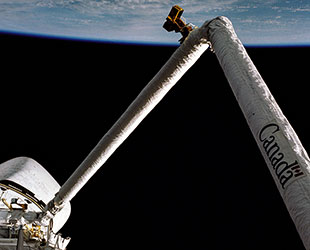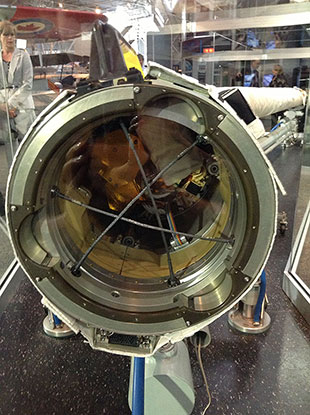May 2, 2013 — The original Canadarm, the Canadian-built robotic arm that for 30 years was used to reach out from NASA's space shuttles to deploy and capture satellites, support spacewalking astronauts and help assemble the International Space Station, now has a new mission in its retirement: public outreach.
Canadian Space Agency officials unveiled the Canadarm's new permanent display at the Canada Aviation and Space Museum in Ottawa, Ontario on Thursday (May 2). Joining the event via a video broadcast from orbit, Chris Hadfield, the first Canadian commander of the International Space Station, participated by "sending the command" to reveal the arm's new exhibit.
"Let me send Canadarm its last command from space," said Hadfield as he simulated entering a command from a laptop aboard the space station. The video was timed with the curtain covering the Canadarm's display being pulled away.

Canadian Space Agency astronaut Chris Hadfield (right, on video screen) sends the command to unveil the Canadarm. (CSA) |
The 50-foot-long (15-meter) Canadarm, which the Canada Aviation and Space Museum has displayed in a V-shaped floor-mounted case, was designed to operate much like a human arm. It has six rotating joints: two at the shoulder, one at the elbow and three at the wrist. In space, it could lift cargo weighing as much as fully-loaded bus while using less electricity than is needed to heat a tea kettle.
Hadfield said the Canadarm provided him the opportunity to become an astronaut.
"I am very grateful to the Canadarm itself — in a sense, it is because of Canadarm that I can even be in space," he said. "More than 30 years ago, when Canada contributed this magnificent, state-of-the-art technology to NASA, it opened the door for Canadian astronauts to exist."
"And about 17 years ago, I was the first lucky Canadian to operate the now legendary Canadarm," Hadfield said.
Five Canadarms — or as they were referred to by NASA, shuttle remote manipulator systems (SRMS) — were built and delivered to the U.S. space agency between 1981 and 1993. The arm now on exhibit was the first to fly in space, launching on the second mission of the shuttle program in November 1981.

Canadarm 201 is seen extended for the first time in space during the STS-2 mission aboard space shuttle Columbia, 1981. (NASA) |
In the three decades since, the SMRS on display, known by its serial number 201, flew 22 more missions mounted inside the cargo bays of all five NASA orbiters, Columbia, Challenger, Discovery, Atlantis and Endeavour. The arm's last flight in 2011 was on the final mission of Endeavour, when it had a hand, literally, in completing the assembly of the International Space Station.
Among the Canadarm 201's other mission highlights were the retrieval of the Long Duration Exposure Facility (LDEF) from orbit, the installation of the Canadian-built, two-arm robotic manipulator Dextre on the space station, and the addition of the Tranquility node and multi-windowed Cupola for the orbiting complex.
In total, Canadarm 201 logged over 215 days in space.
"Thousands of Canadians will soon walk through these doors [of the museum] and have the opportunity to learn and appreciate one of Canada's greatest achievements in the space industry," James Moore, minister of Canadian Heritage and Official Languages, said at the unveiling. "A marvel of technological innovation, created and developed by Canadians, the Canadarm is, simply put, a Canadian icon."
The original arm is now one of two on public display, the other exhibited alongside the retired shuttle Discovery at the Smithsonian National Air and Space Museum's Steven F. Udvar-Hazy Center in northern Virginia.

Looking down the barrel of the Canadarm's end effector that was used to grapple satellites and space station modules. (CASM) |
The last of the Candarms to fly in space, the SRMS flown aboard the final space shuttle mission, STS-135 in July 2011, was shipped to NASA's Johnson Space Center in Houston for engineering study and possible reuse on a future mission. One Canadarm was lost in flight with the destruction of space shuttle Challenger in January 1986. Parts from the fifth arm were used to construct a boom to inspect the orbiters' heat shield for any damage sustained in flight.
Before going on display at the Canada Aviation and Space Museum, Canadarm 201 underwent a careful evaluation at MacDonald, Dettwiler and Associates' (MDA) facilities in Brampton, Ontario. The Canadarm was designed, built and tested by Spar Aerospace, which was acquired by MDA.
In addition to now displaying the Canadarm, the Canada Aviation and Space Museum hosts the Canadian Space Agency's "Living in Space" exhibit with artifacts loaned by all of Canada's astronauts.
